hankyoreh
Links to other country sites 다른 나라 사이트 링크
[Korea travels] Chuncheon’s alleyways blend old-school classics with newfound fun
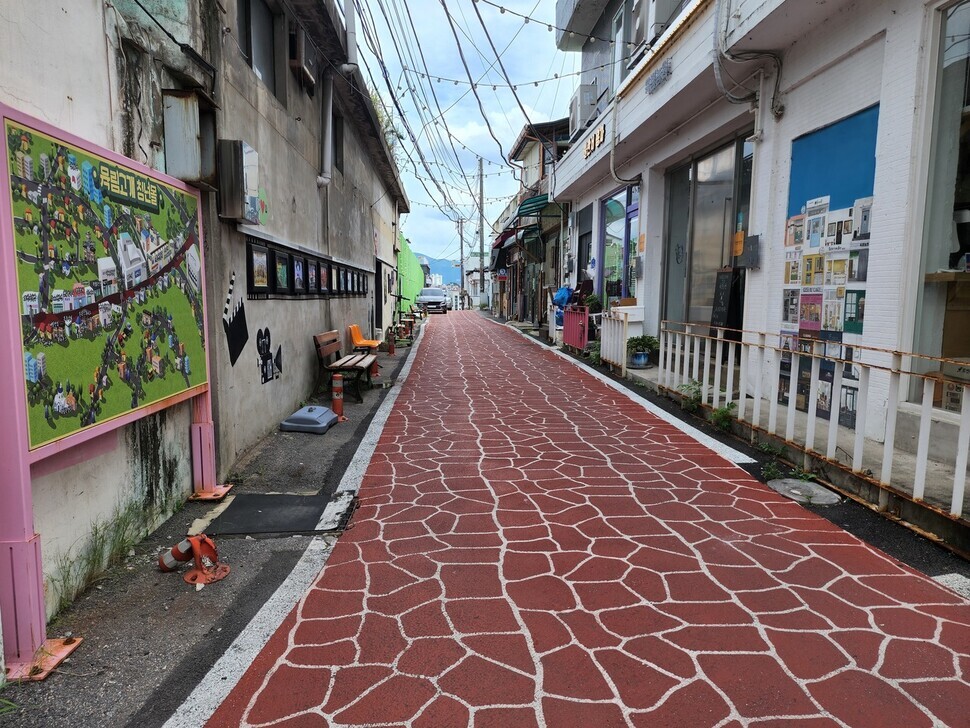
“Yuknim Pass combines old stores that carry the marks of all the years with other establishments run by hip younger people. This isn’t a place that artificially imitates a ‘vintage’ feel — this is ‘living retro.’”
This was how Choe Jeong-hye, proprietor of the local accessory shop Chuncheon Diary, explained the Yuknim Pass area in the Ungyo neighborhood of Chuncheon, Gangwon Province, when the Hankyoreh visited on Aug. 18. This uphill road runs for 500 meters between the former Yuknim Theater and the vicinity of Nangman Market (Central Market).
The road is named after the theater, which opened its doors in 1967. In the 1960s and 1970s, it was also known as "Magari Pass” or “Migari Pass” — migari/magari meaning “shack” — because of the many street stalls there selling military uniforms and US-made items.
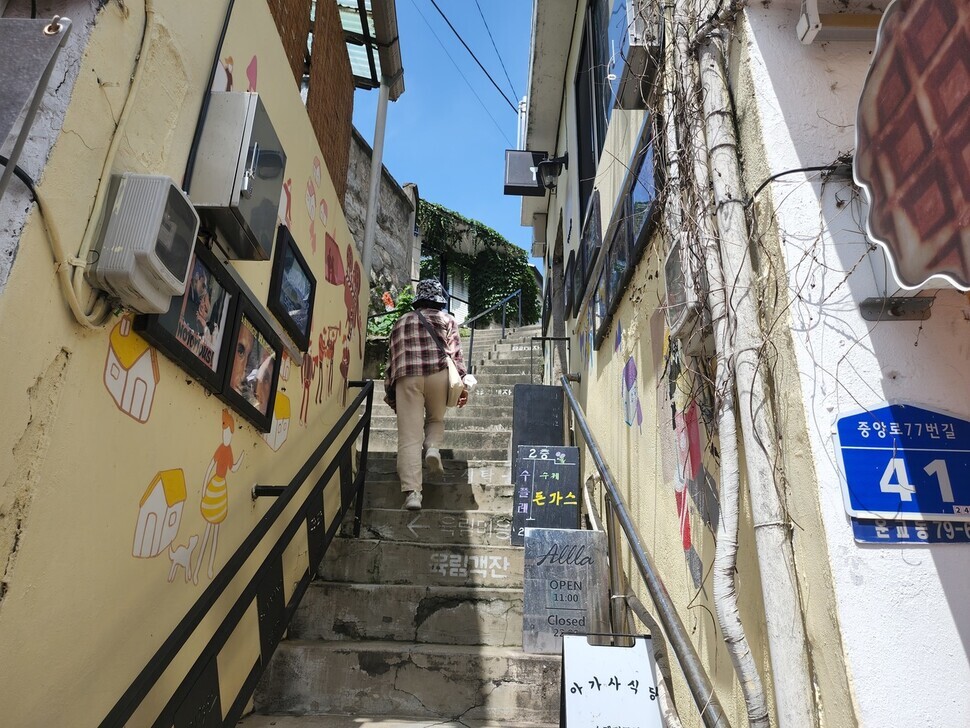
As supermarkets and outlets began appearing in the area during the 2000s, Yuknim Pass’s market went through a decline that saw over half the stores shut down. Things began to turn around in 2017, when young people began opening up stores in the area, many of them through a project aimed at nurturing younger merchants in traditional markets. As more and more young people started flocking to the neighborhood, it became locally known as the “hill of youth.”
These days, Yuknim has been drawing attention for its retro vibe. Some of the establishments have been holding out like deeply rooted trees boasting histories dating back 40 years or more: “tadpole noodle” restaurants, popcorn sellers, oil shops, beauty salons and so on. Next to them, newer stores have a strongly idiosyncratic feel, including coffee shops built in renovated old houses and tarot readers with exteriors painted in purple.
At the top of the ridge is a space that displays guide maps to the different stores, film posters, and works of art in the area. This is also a picture-taking stop for visitors to the neighborhood.
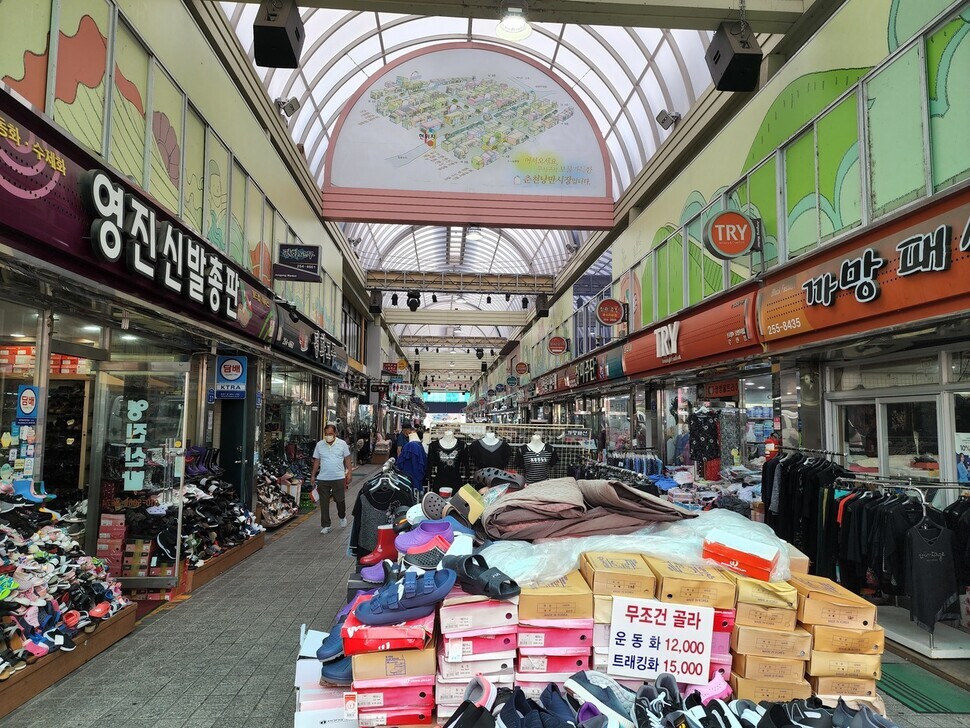
The old Chuncheon city center consists of the neighborhoods of Yaksamyeong, Hyojo, Gyo-dong, and Joyang in addition to Ungyo, where Yuknim Pass is located. This area between Chuncheon and South Chuncheon train stations boasts eight different commercial districts, including Yuknim Pass as well as Nangman Market, Brown 5th Avenue, and the Myeong-dong Dakgalbi (spicy stir-fried chicken) Street.
Heading down from Yuknim Pass, you find the road for Nangman Market, Chuncheon’s premier traditional market. A setting for town market days since the Joseon era, it became a permanent market during the 1950s when 595 different small stores were built there by US troops.
The Korean War altered the market’s landscape. When a US military unit was stationed in Chuncheon after the war, Nangman Market became known as the “Yankee market” as it acquired more and more of the items used by US troops.
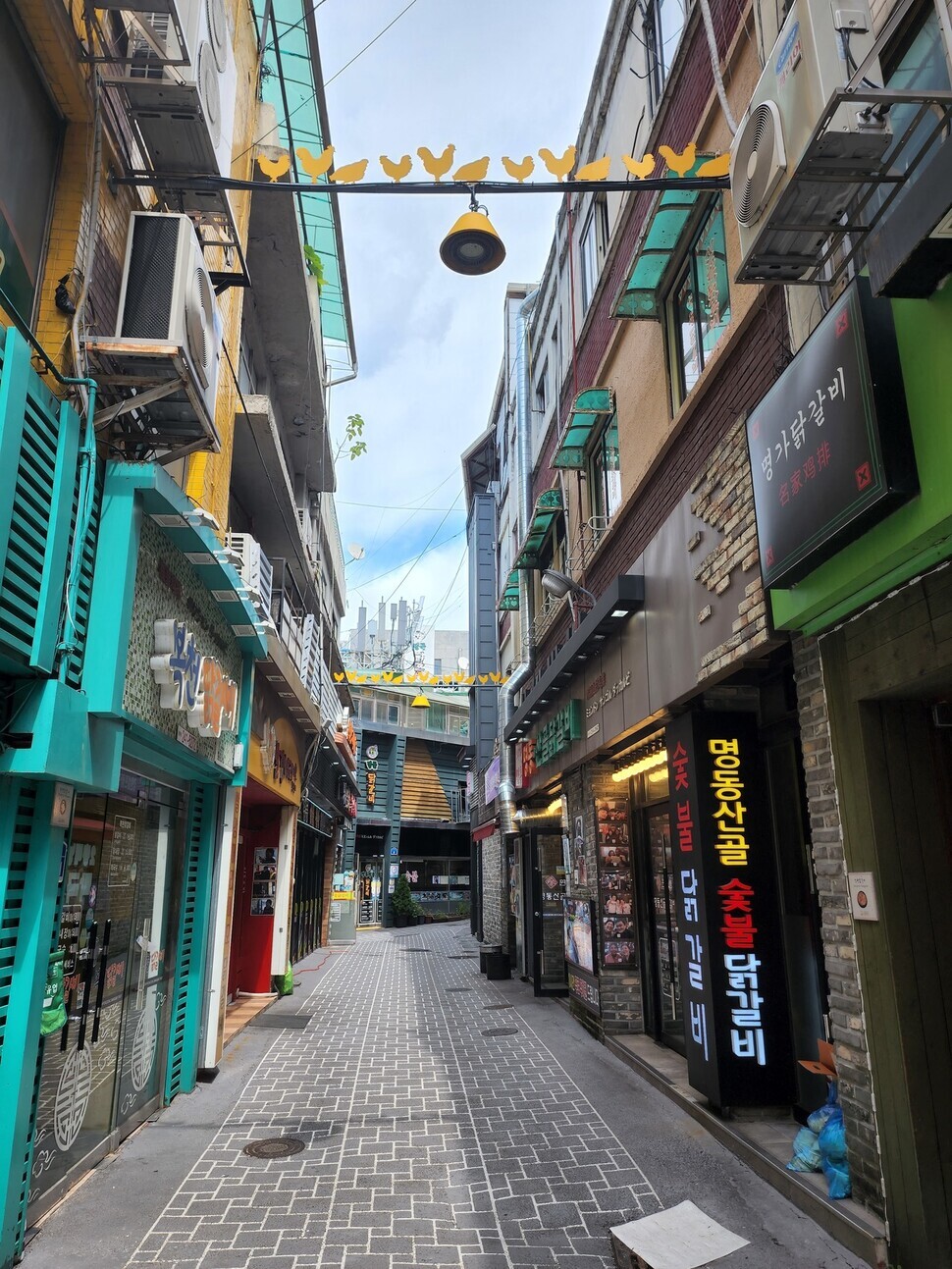
These days, that history is being carried on by just three or four establishments selling clothing and other items. Nangman Market’s fifth gate was the Yankee market site.
“I took over the store from my mother, and I’ve been doing business here for 50 years,” explained the owner of one store selling imported goods at Gate 5.
“The number of consumers has dropped off quite a bit, but some of the regulars have been coming here since my mother’s day, and most of our customers are in their forties and forties,” they said, adding that the “imported shoes are the most popular among visitors.”
Some of the establishments are quite storied, having carried on within the market through the hardships of history.
Park Geum-suk, an 80-year-old who has run Jungrim Bindaetteok, a mung bean pancake shop, for 50 years, uses a millstone to grind buckwheat to make jeonbyeong, or traditional buckwheat crepes.
“Central Market was the biggest market in Chuncheon,” she explained.
“Before, there were display stands set up all the way from the market to Yuknim Pass by people selling things out of rubber pails,” she recalled.
“There were a lot of customers back then, with people coming from places like Hongcheon, Hwacheon and Yanggu. There were so many people that if you left your items on the ground, someone might snatch them up and you’d never even know it.
“These days, the market buildings are nicer than they were, but there are a lot fewer people.”
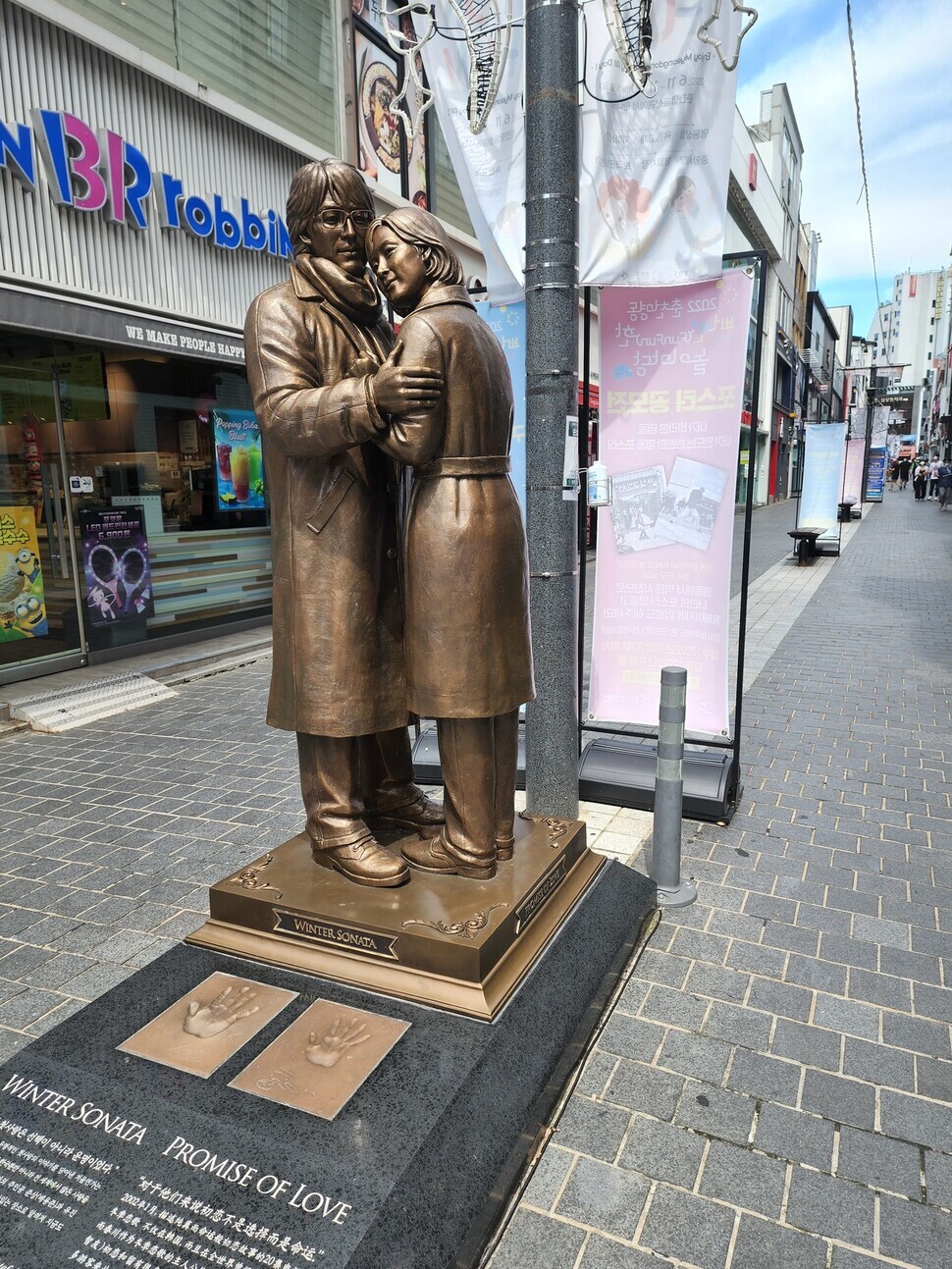
Next to Nangman Market is Myeong-dong Dakgalbi Street, a culinary culture road devoted to spicy stir-fried chicken. It has around 20 different establishments selling two of Chuncheon’s most renowned dishes: dakgalbi and makguksu (buckwheat noodles).
At the street’s entrance is a sculpture of a chicken with the number “1968” underneath, signifying the year in which the street was created. The history of Chuncheon dakgalbi is said to date back to the 1960s, when people would marinate chicken instead of pork to grill like ribs over a charcoal fire. From there it transformed into its current form, where vegetables like cabbage and onions are mixed in with the chicken and stir-fried on an iron plate.
During the early 1970s, dakgalbi was an affordable dish that delivered a filling meal for the cost of around 100 won per serving. This made it quite popular among college students and soldiers. At the time, dakgalbi was popularly known as “working class ribs” or “college student ribs.”

The Myeong-dong commercial area where the Dakgalbi Street is located also offers a look back at a fondly remembered TV series. A statue there depicts Bae Yong-joon and Choi Ji-woo, the lead actors in “Winter Sonata” (2002), a miniseries that touched off the “Korean Wave” of the ’00s. In the past, tourists from places like Japan and Taiwan would line up to take photographs there while visiting Chuncheon, where the series was filmed.
“The old city center is about a 20-minute walk from Chuncheon Station,” explained Park Ra-hwa, who works as a culture and tourism guide for the city.
“The Dakgalbi Street, Nangman Market, and Yuknim Pass Market are close by, so you can visit all of them in one go,” she said. “Because there are so many markets in Chuncheon’s original downtown, you can see from up close how the people there live, while enjoying Chuncheon’s various dishes.”
Choe Jeong-hye, the owner of Chuncheon Diary, said, “Chuncheon has a lot of renowned tourist destinations like the Soyang River or Nami Island, but there’s a unique charm to visiting the old downtown.”
“As you walk through the different parts of the old city center, you can get a real local experience, like you’re just going about your ordinary life there,” she explained.

Chuncheon’s old downtown also has a course for those who like traveling through storied side streets. This is Mangdae Road, located in the neighborhood of Yaksamyeong.
As you make your way up along a road that is only wide enough for one person to pass, you will see a white three-story structure. This is the watchtower (mangdae), which resembles a lighthouse on a hill. Built in the 1930s during the Japanese occupation for use in watching for fires, it is one of the oldest structures in Chuncheon.
From the watchtower’s location, visitors can survey the surrounding old downtown landscape, including Nangman Market and Jungnim-dong Cathedral. The neighborhood here is said to have been created during the 1960s and 1970s as merchants at the market built homes on the slopes near the tower. Famously, it is where the painter Park Su-geun earned money doing manual labor while living in Chuncheon, and it is also where the sculptor Kwon Jin-kyu boarded for three years.
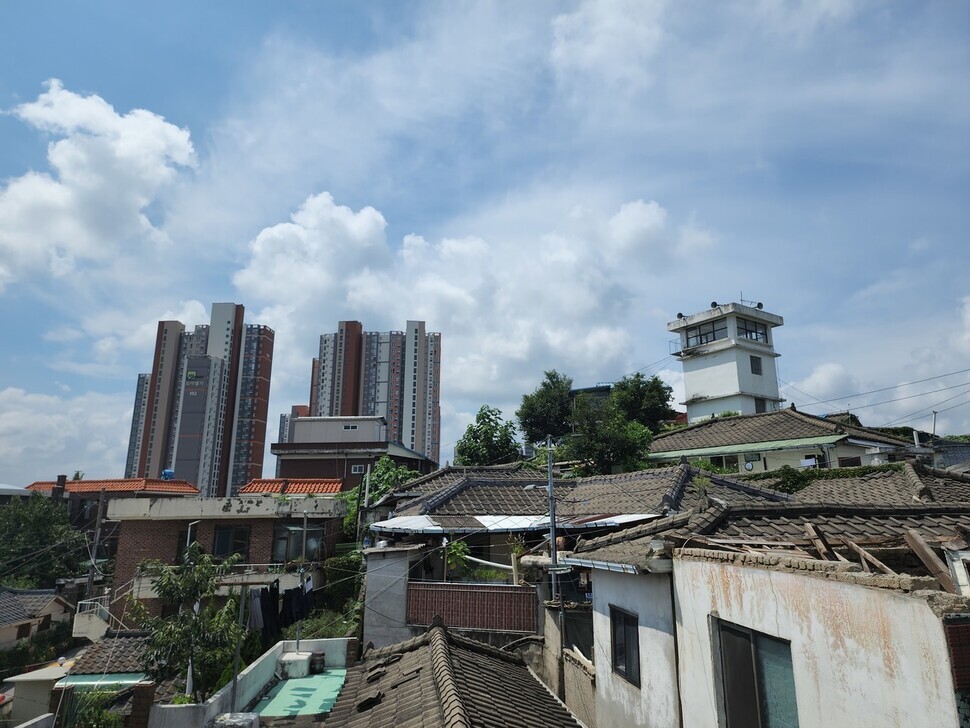
The area around the tower shows the layers left behind by the passage of years, including the densely clustered slate-roofed homes and the old, rusted gates. These days, its fate remains uncertain, with the looming possibility that it will end up lost to redevelopment.
The neighborhood also offers a heartwarming experience with a side street featuring wall murals. The Nangman Side Street in the Hyoja neighborhood is about a 15-minute walk from Mangdae Street. This neighborhood is renowned for the story of Ban Hui-eon, a Joseon-era figure considered a paragon of the dutiful son for the way he went out in midwinter to find wild ginseng and strawberries for his ailing mother.

Beginning at the Hyoja No. 1 neighborhood’s community center and continuing for 1.1 kilometers, Hyoja Nangnam Street centers on three different themes. There is the “heartwarming course,” which focuses on the story of Ban’s filial piety; the “retro course,” which shows the side streets of the 1970s and 1980s; and the “imagination course,” which features images of various characters, including Cloud Bread and cats.
Those who wander down the winding road can enjoy all the different pictures on the wall, which show tigers, fish, housecats, and students in uniform. At the end of the street is a “library with low walls,” where visitors can rest and read.
Photos and article by Her Yun-hee, staff reporter
Please direct questions or comments to [english@hani.co.kr]

Editorial・opinion
![[Editorial] Penalties for airing allegations against Korea’s first lady endanger free press [Editorial] Penalties for airing allegations against Korea’s first lady endanger free press](https://flexible.img.hani.co.kr/flexible/normal/500/300/imgdb/original/2024/0502/1817146398095106.jpg) [Editorial] Penalties for airing allegations against Korea’s first lady endanger free press
[Editorial] Penalties for airing allegations against Korea’s first lady endanger free press![[Editorial] Yoon must halt procurement of SM-3 interceptor missiles [Editorial] Yoon must halt procurement of SM-3 interceptor missiles](https://flexible.img.hani.co.kr/flexible/normal/500/300/imgdb/child/2024/0501/17145495551605_1717145495195344.jpg) [Editorial] Yoon must halt procurement of SM-3 interceptor missiles
[Editorial] Yoon must halt procurement of SM-3 interceptor missiles- [Guest essay] Maybe Korea’s rapid population decline is an opportunity, not a crisis
- [Column] Can Yoon steer diplomacy with Russia, China back on track?
- [Column] Season 2 of special prosecutor probe may be coming to Korea soon
- [Column] Park Geun-hye déjà vu in Yoon Suk-yeol
- [Editorial] New weight of N. Korea’s nuclear threats makes dialogue all the more urgent
- [Guest essay] The real reason Korea’s new right wants to dub Rhee a founding father
- [Column] ‘Choson’: Is it time we start referring to N. Korea in its own terms?
- [Editorial] Japan’s rewriting of history with Korea has gone too far
Most viewed articles
- 160% of young Koreans see no need to have kids after marriage
- 2Presidential office warns of veto in response to opposition passing special counsel probe act
- 3Months and months of overdue wages are pushing migrant workers in Korea into debt
- 4[Editorial] Penalties for airing allegations against Korea’s first lady endanger free press
- 5Japan says it’s not pressuring Naver to sell Line, but Korean insiders say otherwise
- 6Hybe-Ador dispute shines light on pervasive issues behind K-pop’s tidy facade
- 7S. Korea “monitoring developments” after report of secret Chinese police station in Seoul
- 8[Column] Unsettling moves by the UN Command lay way for Korean involvement in Taiwan
- 9[Reporter’s notebook] In Min’s world, she’s the artist — and NewJeans is her art
- 10Inside the law for a special counsel probe over a Korean Marine’s death